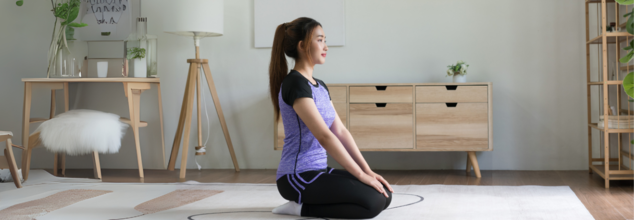
From Walking 25000 Steps Daily To 7300 Kms In A Year, Meet The Man Who Walked His Fitness Back Into His 20s
What if the road to reclaiming your health, sanity, and strength didn’t begin at a gym, but with a single step—on a sidewalk, at dawn, with no plan in sight? That’s exactly how Rohit Sakunia’s journey began. No personal trainer. No fancy gear. Just the resolve to put one foot in front of the other.
From feeling stuck and overwhelmed to walking over 7,300 kilometers in a single year—Rohit’s story isn’t just about physical transformation. It’s about how movement became his medicine, walking became his therapy, and discipline became his greatest motivation. If you’ve ever felt lost and unsure where to start, this real-life story might be the push you need to simply start walking your way back to yourself.
When 39-year-old Rohit Sakunia, founder of ARTE Media, began walking, it wasn’t with the intention of rewriting his health story. There were no fancy trackers, no grand fitness plans, and no public proclamations. Just a quiet, deeply personal decision to move—both physically and emotionally—through a difficult chapter of life. What started as a way to cope with a personal setback became a transformation that saw him walk more than 7,300 kilometers in a single year—a distance equal to walking from New Delhi to Reykjavik, Iceland.
This is not just a story of endurance. It’s about discipline, emotional resilience, and redefining what fitness really means when you're nearly 40 and striving to reclaim your twenties.
Rohit's journey began in late 2018 following a deeply personal and destabilizing event. With no history in fitness or athletic discipline, and a lifestyle far from ideal—loose clothes to hide weight gain, impulsive eating, and emotional disconnection—he found himself spiraling. "I wasn’t a drinker, so alcohol wasn’t an option. But I was anxious, depressed, and had no idea how to move forward," he says.
In that haze, walking emerged not as a fitness resolution but as a coping mechanism. “I needed to feel like I had some control over my life. Walking just a few minutes a day gave me that.” What started with 3,000 steps grew steadily into 10,000 and beyond. Despite criticism—“You’re just chasing a number from some Japanese marketing campaign”—Rohit stayed the course. “So what if I was? I wasn’t hurting anyone.”
Walking as Therapy, Not a Trend
By 2023, what began as a simple daily routine became a full-fledged commitment. Rohit clocked in 20 kilometers every single day, rain or shine, sometimes even more. “Some days it was 25, others 30. Shimla was particularly intense; I had time, space, and nature—and that fueled me.”
Yet, the transformation wasn’t just in kilometers or calories burned. “It wasn’t about fitness at the start. It was survival. Solitude. Sanity. Just me, my thoughts, and the road,” he reflects. Rohit explains how the rhythm of walking gave him something he hadn’t found in years: clarity.
“The emotional and mental shifts were profound. Every morning, I’d spend two hours with myself. No phone buzzing, no meetings, just fresh air and honesty. It helped me process grief, fear, self-doubt—all the things I didn’t even realize I had buried.”
By the end of 2023, Rohit had covered a staggering 7,300 kilometers on foot—an achievement few can claim. But the journey didn’t stop there. “As empowering as it was, I realized I needed more than just endurance. I needed strength.”
Now, he maintains a consistent 12-kilometer walking routine daily and has added strength training to his fitness regimen. “I’m no longer chasing step counts. I’m chasing growth. Peace. Power. Discipline.”
This shift in mindset—from metrics to meaning—marks the real milestone. “It’s not about proving anything to the world. It’s about honoring a promise I made to myself: to not quit when I had every reason to.”
No fitness transformation is complete without dietary changes, and Rohit’s case is no exception. His diet today focuses on clean eating: generous servings of green vegetables, lean proteins, and healthy fats. He follows intermittent fasting and drinks around 3.5 liters of water daily.
“I don’t believe in extreme restrictions. It’s about consistency and balance. I make sure my meals are aligned with my fitness needs—enough protein, carbs, and hydration. The goal is to feel nourished, not punished.”
Micro Habits, Major Discipline
Rohit’s routine is a masterclass in how small habits can create massive change. From walking during meetings to taking stairs instead of elevators and logging 6,000–8,000 steps after dinner, he’s woven movement into his everyday schedule.
“It’s not about finding time. It’s about making time—even when your day is packed. That’s where discipline > motivation.”
He also emphasizes how fitness became his non-negotiable: “Work can wait. Emails can wait. But showing up for yourself? That’s a priority.”
Now in a phase of maintenance and evolution, Rohit’s goals have evolved. “I’m building a lifestyle, not chasing a finish line. I want to see what my best self looks like—just once. And I want to do that with intention, not obsession.”
For anyone starting out, his advice is straightforward: “You don’t need fancy plans. Just start walking. You don’t even need motivation—just a reason. And once you begin, honor that commitment with everything you’ve got.”
And sometimes, the most radical thing you can do for your health is something as simple, and as transformative, as putting one foot in front of the other.

(Credit-Canva)
Walking Like This Helps You Burn More Calories!
Walking is one of the best exercises you can do. It engages all your important muscles and helps you burn a lot of calories. It is one of the most accessible forms of exercise that is great for beginners. There are also many ways that you can increase how many calories you burn. One such variation is the Nordic walking. Harvard Health Publishing tells us that Nordic walking is like taking your regular walk and adding a boost with special poles. This exercise was originally created for cross-country skiers to keep up their training during the summer months when there's no snow.
You can say it is similar to cross-country skiing but with no ice and on solid ground! Now, it's become a popular activity for everyone, especially older adults. It's a great way to get moving and get some fresh air, you may think using that the poles people are using is to support themselves, but these poles are meant to mimic the ski poles that boost you on the snow, these poles helps you engage more muscles than just regular walking, turning a simple stroll into a full-body workout. It's easy to learn and can be done almost anywhere.
Why It's Good for You?
Nordic walking is fantastic because it works both your heart and your muscles. It's like getting two workouts in one. Harvard Health Publishing explains that when you walk normally, you mostly use your leg muscles. However, when you add the poles, you start using your arms, shoulders, and core too. This means you're burning more calories, which is great for weight management. It also helps improve your heart health by increasing your heart rate. Plus, it can lower your bad cholesterol and raise your good cholesterol, which is good for your arteries. Nordic walking can also make you feel better mentally by reducing stress and anxiety. Furthermore, because the poles help with balance, you're less likely to fall, which is especially important as you get older.
How Can You Get Started?
To start Nordic walking, you'll need a pair of special poles. These aren't the same as regular hiking poles. Nordic walking poles have a special strap that fits around your wrist like a glove, which helps you push yourself forward. You can find these poles at most sporting goods stores or online. Once you have your poles, you can start practicing the techniques. There are two main techniques: double poling and single poling. Single poling is easier to learn, so it's a good place to start. Just swing one pole at a time, matching the movement of your legs. As you get better, you can try double poling, where you plant both poles at the same time.
The good news is that almost anyone can try Nordic walking. It's a low-impact exercise, which means it's gentle on your joints. Even if you have balance problems, the poles can actually help you feel more stable. However, it's always a good idea to talk to your doctor before starting any new exercise program, especially if you have any health conditions. Once you have your doctor's approval, you can choose a place to walk. You can walk on sidewalks, trails, or in parks. Just make sure the surface is relatively even and safe. You can even join a Nordic walking group, which is a great way to meet new people and stay motivated.

(Credit-Canva)
Sitting For Elongated Hours? Yoga To Relieve Lower Back Pain
Yoga is one of the best ways to ensure your body’s well-being. Whether you are trying to build muscle, increase your flexibility or relieve pain, yoga helps. The stretches and poses in yoga can help you work all your muscles as well as joints. One of the most popular ones are back exercises.
There are many reasons why your back may be hurting. With people spending more hours sitting on desks, whether it is for their jobs, studying etc. When you exercise your back, not only will you strengthen your back muscles, but you will also strengthen your core. Weak core muscles can also contribute to back pain during everyday activities. Medical experts agree that any exercise that strengthens the core is beneficial for lower back pain. While studies suggest yoga isn't significantly superior to other forms of exercise and stretching, it may offer long-lasting pain relief.
Downward-Facing Dog
This classic pose stretches and strengthens almost all muscles, relieving pressure on the spine and easing back tension. Start on hands and knees, lift knees off the floor, and raise your tailbone towards the ceiling, pressing into your hands. For a deeper lower back stretch, bend your knees and lengthen your tailbone upwards.
Child's Pose
Despite appearing restful, Child's Pose effectively stretches the back and hip muscles. It's also a great way to de-stress, especially before bed. Begin on hands and knees, bring big toes together, widen knees, and press hips back towards heels. Walk arms forward, resting forehead on a block, folded arms, or the mat, allowing shoulders to soften.
Reclined Half Pigeon
This variation of Pigeon Pose stretches the hip rotators and flexors. Tight hips can contribute to lower back pain, making this stretch beneficial. Lie on your back with bent knees, cross your left ankle over your right thigh, and thread your left arm through the leg triangle. Hold your right shin or hamstring with both hands, flex both feet, and hug legs towards your body, breathing into hips and lower back.
Triangle Pose
Triangle Pose effectively stretches both the hips and the spine. Facing the long edge of your mat, extend arms to a T and step feet wide. Turn your right toes to the top of the mat and angle your left foot slightly inward. Engage your core as you reach your right arm and torso forward, placing your right hand on the ground or a block outside your right ankle. Extend your left arm straight up, gazing towards your left thumb or straight ahead.
Cat-Cow Pose
Moving between Cat and Cow stretches the back muscles, lengthening and increasing the spine's flexibility. Start on hands and knees, aligning hands under shoulders and knees under hips. Tuck toes for stability and engage your lower abdomen. Inhale, relax your belly down, draw shoulder blades together to open your chest, and lift your gaze into Cow Pose. Exhale, arch your back into Cat Pose, pressing the ground away and tucking your chin to your chest.
Standing Forward Bend
This pose stretches the hamstrings and back muscles. Stand with feet shoulder-width apart and knees loose. Exhale as you hinge at your waist and bend forward, reaching towards the floor. Bending your knees helps lengthen the lower back and deepen the stretch in the legs. Hold for 10 to 20 breaths and repeat as needed.
Low Cobra
Low Cobra helps strengthen the back muscles, promoting healthy lower back alignment and body awareness. Lie on your stomach with forehead on the mat, slide palms back to align thumbs with lowest ribs, and press down through the tops of your feet. Inhale, engage your back body, and curl your chest up, pressing palms into the mat and drawing shoulder blades down and in. Hold for one to five breaths and repeat two to three times.

(Credit-Canva)
Sitting In This Yoga Pose Can Boosts Digestion And Relieve Constipation
Unlike what many people believe, yoga can be easily added into your daily routine and activities. Yoga asanas can be done throughout the day, without making it too overwhelming. For example, doing the mountain pose along with some stretches after you wake up to doing the child pose, followed by cobra pose before bed. Another such yoga pose is Vajrasana, or the thunder or the diamond pose. This is a sitting pose which is not only vital for our posture, but also for digestion.
Doing this yoga pose, after eating for about 10-15 minutes, improves digestion and is a great aid to relieve constipation. This pose is often recommended as a meditational pose or a breathing pose, as it brings about calmness and focus on our body. There are many benefits of Vajrasana.
Benefits of Vajrasana
- Improve concentration
- Reduce feelings of anxiety
- Increase body flexibility
- Lower blood pressure and heart rate
- Help manage symptoms of type 2 diabetes
It's important to remember that yoga should not replace any existing medical treatments, such as medication, unless you have discussed this with a healthcare professional.
How to Perform the Vajrasana Pose
Here is a step by step guide on how to do the Vajrasana pose:
Step 1
Begin by kneeling on the floor. Using a yoga mat can make this more comfortable.
Step 2
Bring your knees and ankles close together, pointing your feet straight back in line with your legs. The soles of your feet should face upward, with your big toes touching.
Step 3
As you exhale, slowly sit back onto your legs. Your buttocks will rest on your heels, and your thighs will rest on your calves.
Step 4
Place your hands on your thighs and gently adjust your pelvis slightly forward or backward until you find a comfortable position.
Step 5
Breathe slowly in and out as you straighten your spine to sit up tall. Imagine the top of your head pulling you upward and gently press your tailbone down towards the floor.
Step 6
Keep your head straight, looking forward with your chin parallel to the floor. Rest your hands on your thighs with your palms facing down and your arms relaxed.
Tips To Make Vajrasana More Comfortable
To make Vajrasana more comfortable or less challenging, several adjustments can be helpful. For those who experience ankle pain, placing a folded blanket or even another cushion under the shin, allowing the toes to extend off the back, can provide relief. If knee pain is an issue, try positioning a rolled or folded blanket or towel across the calves and tucking it behind the knees for added support. Finally, for general sitting discomfort, placing a yoga block horizontally between the feet can help support some of your weight and reduce pressure on both the ankles and knees.
When Should You Avoid Doing Vajrasana?
It's a good idea to talk to your doctor before starting any new yoga program. They can advise you on how yoga might affect your current health and suggest ways to avoid potential problems. It is often recommended that you should not perform Vajrasana if you have knee problems or have recently had surgery or a spinal cord condition, especially involving the lower part of your spine. Another reason why you should avoid this is if you have intestinal ulcers, a hernia, or other intestinal issues.
© 2024 Bennett, Coleman & Company Limited

